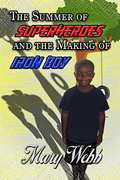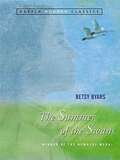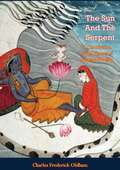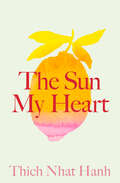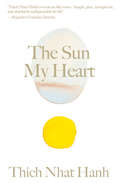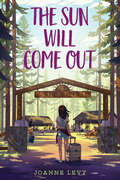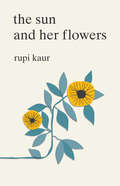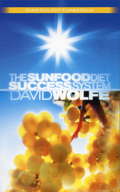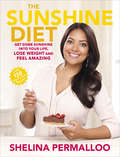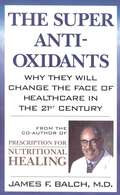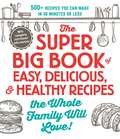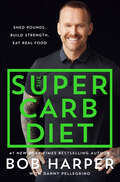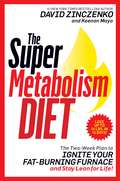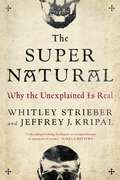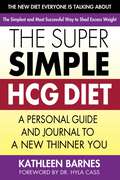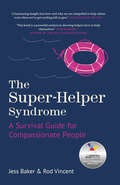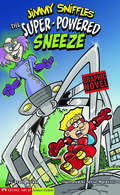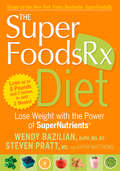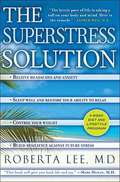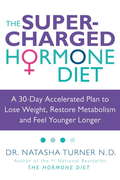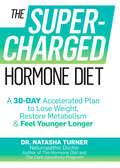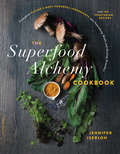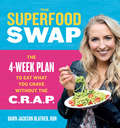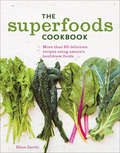- Table View
- List View
The Summer of Super Heroes and the Making of Iron Boy
by Mary WebbAre unique occurrences in life that stop and give you pause mere coincidences? Or are they really perfectly timed miracles from God? When completely healthy 4-year-old Quentin's sudden mysterious ailments result in a diagnosis of leukemia, his mother chooses to believe that the diagnosis is an answer to prayer. She also begins to recognize that everything that has happened leading up to the diagnosis and everything that will happen on the way to Quentin's total healing is the work of the Lord. The Summer of Superheroes and the Making of Iron Boy is a chronicle of all those blessings, otherwise known as miracles.
The Summer of the Swans
by Betsy ByarsSara's fourteenth summer was turning out to be the most confusing time of her life. Up until this summer, things had flowed smoothly, like the gliding swans on the lake. Now she wants to fly away from everything--her beautiful older sister, her bossy Anut Willie, her remote father, and most of all,herself. But can she run away from Charlie? Sara loves her brother so much, and in a way she can't understand, though sometimes she can't stand his neediness. But when Charlie himself flies away, Sara knows what she must do. <P><P> Winner of the Newberry Medal.
The Sun And The Serpent: A Contribution to the History of Serpent-Worship
by Charles Frederick OldhamTHIS work, which is based upon papers read before the Royal Asiatic Society in 1901, was, at first, intended to refer only to Indian Serpent-worship. It was soon found, however, that the Serpent-worship of India did not originate in that country, but was, in fact, a branch of the worship of the Sun and the Serpent, which was once well-nigh universal. It became evident, therefore, that a history of the Indian cult would go far to explain the nature and origin of serpent-worship, in other countries and in other times.It will be seen that some of the views, expressed in this volume, differ from those which have been held by some Oriental scholars of great eminence. These views, however, have not been put forward without due consideration. They are the result of much reflection, observation, and inquiry, combined with a careful study of local tradition and folklore. For this, a long residence in India, and an intimate acquaintance with the people, afforded many facilities.
The Sun My Heart: The Companion to The Miracle of Mindfulness
by Thich Nhat HanhThis sequel to The Miracle of Mindfulness offers accessible, eye-opening guidance for spiritual seekers on the path from mindfulness to true insight The Sun My Heart is one of Thich Nhat Hanh&’s most beloved books. Using the objects and events of everyday life in his hermitage in Plum Village—the gradual settling of the pulp in a glass of apple juice or the wind blowing into the room and scattering papers about—Thich Nhat Hanh draws from Buddhist psychology, epistemology, and the world of contemporary literature and science to guide the reader along the path of clarity and understanding. This book can be read straight through, but is also designed to be opened randomly and experienced chapter by chapter, paragraph by paragraph. Thich Nhat Hanh suggests in the introduction that The Sun My Heart &“prefers to be a friend rather than a book. You can take it with you on the bus or subway as you do your coat or your scarf. It can give you small moments of joy at any time.&”
The Sun My Heart: The Companion to The Miracle of Mindfulness (Thich Nhat Hanh Classics)
by Thich Nhat HanhThe Sun My Heart is one of Thich Nhat Hanh’s most beloved books. It was written as a sequel to Miracle of Mindfulness and contains the journey, on the path of everyday practice, from mindfulness to insight in an informational, conversational manner. Using the objects and events of everyday life in his hermitage in Plum Village—the gradual settling of the pulp in a glass of apple juice or the wind blowing into the room and scattering papers about—Thich Nhat Hanh draws from Buddhist psychology, epistemology, and the world of contemporary literature and science to guide the reader along the path of clarity and understanding.This book can be read straight through, but is also designed to be opened randomly and experienced chapter by chapter, paragraph by paragraph. Thich Nhat Hanh suggests in the Introduction that The Sun My Heart "prefers to be a friend rather than a book. You can take it with you on the bus or subway as you do your coat or your scarf. It can give you small moments of joy at any time."
The Sun Will Come Out
by Joanne LevyThe Sun Will Come Out is a funny and heartwarming account of a shy girl’s first summer away from home, where she learns she really can do anything and that silver linings can be found just about anywhere. Twelve-year-old Bea Gelman and her best friend Frankie are planning the BEST SUMMER EVER at Camp Shalom—a sleep-away camp. But at the last minute, Frankie bows out, leaving painfully shy Bea on her own. Just talking to strangers causes Bea to break out into ugly, blotchy hives. As if the hives weren't bad enough, Bea gets pranked by a couple of girls in her cabin and is betrayed by someone she thought was a new friend. Bea has had enough! She decides to spend her summer in the infirmary far away from everything that’s stressing her out. No more boys (including her crush, Jeremy), no more horrible mean girls, and no more fake friends! At the infirmary, Bea meets Harry, a boy facing challenges way more intense than stress breakouts. Inspired by Harry’s strength and positive outlook, Bea decides to face her fears—in a big way. The epub edition of this title is fully accessible.
The Sun and Her Flowers
by Rupi Kaur<P>From Rupi Kaur, the #1 New York Times bestselling author of milk and honey, comes her long-awaited second collection of poetry. A vibrant and transcendent journey about growth and healing. Ancestry and honoring one’s roots. Expatriation and rising up to find a home within yourself. <P>Divided into five chapters and illustrated by Kaur, the sun and her flowers is a journey of wilting, falling, rooting, rising, and blooming. A celebration of love in all its forms. <P> this is the recipe of life said my mother as she held me in her arms as i wept think of those flowers you plant in the garden each year they will teach you that people too must wilt fall root rise in order to bloom <P><b>A New York Times Bestseller</b>
The Sunflower Forest
by Torey L. HaydenFrom the Book Jacket: "Torey Hayden has the rare ability to write about love and hate and loyalty in ways which never fail to move the reader. I was deeply touched by The Sunflower Forest. Rabbi Harold Kushner, author of When Bad Things Happen to Good People The stunning fiction debut of a writer whose great compassion for youth and extraordinary narrative power have endeared her to readers everywhere. How do you keep it together when you're a normal, well-adjusted teenager in a family gone mad? Seventeen-year-old Lesley doesn't know. Justifiably preoccupied with high school, the prospect of college, and her first serious romance, she must also deal with a mother whose dark and tragic past in Nazi-occupied Europe drives her closer to insanity every day; with a father unwilling to acknowledge his wife's deteriorating mental state; and with a sister too young to know the difference between craziness and health. Torn between an intimate reality that is insane and the worldly pressures of her own coming of age, Lesley must muster all her strength-to stand firm in the face of the cataclysm that will soon come down on all their heads.
The Sunfood Diet Success System
by David WolfeSince its first publication, The Sunfood Diet Success System has been the definitive book on the raw food lifestyle. Now after more than seven years, David Wolfe has rigorously rewritten the entire book, beginning to end, in order to offer the most complete, up-to-date nutrition information possible. No where else will you find the kinds of empowering information and insight that is present on every page of this truly inspiring work.The Sunfood Diet Success System is a groundbreaking book in the field of raw-food nutrition. The book describes exactly how to adopt, maintain, and stay centered on an 80, 90, or 100% raw-food diet by balancing different types of foods through David Wolfe's innovative Sunfood Triangle. Success is inevitable with day-by-day menu plans, delicious recipes, and the best information available on detoxification, fasting, mineralization and success technology all neatly bundled into one book.Each chapter is filled with inspiring quotes, facts, and tips. Dozens of beautiful, never-before-seen full-color images have been added to this brand-new edition, including many stunning Kirlian photographs. The Sunfood Diet Success System also includes a comprehensive listing of raw-food restaurants, healing retreats, and organizations. Be prepared for nothing less than total transformation!
The Sunshine Diet: Get Some Sunshine into Your Life, Lose Weight and Feel Amazing – Over 120 Delicious Recipes
by Shelina PermallooShelina knows how easy it is to let a busy lifestyle get in the way of looking after your health. Here, the food-loving MasterChef winner shares her favourite healthy recipes, inspired by exotic holidays and her Mauritian heritage, that helped her lose over 20 kilos (3 stone). Her diet is simple - homemade, whole food, packed with flavour and colour. Her recipes will keep you feeling full and happy as you shed the pounds and get into the best health - try Steamed Hake with Wasabi, Soy and Ginger, Baked Moroccan Eggs, Braised Chicken with Tamarind and Pak Choi, Roasted Aubergines with Fennel and Labneh and Make-ahead Banana Bread and Orange Blossom and Rose Creme Brulee. This is healthy eating made simple, effortless and sustainable. Includes beautiful food photography and each delicious recipe comes with a calorie, sugar and fat count per portion so you know exactly what you're eating. All recipes have been nutritionally approved.
The Super Anti-Oxidants: Why They Will Change the Face of Healthcare in the 21st Century
by James F. BalchThis book provides detailed information about various illnesses and how they can be prevented or cured through the use of anti-oxidants.
The Super Big Book of Easy, Delicious, & Healthy Recipes the Whole Family Will Love!: 500+ Recipes You Can Make in 30 Minutes or Less
by Adams MediaMore than 500 healthy, quick, easy, and delicious recipes with limited sodium, sugar, and fat—perfect for busy families!What’s for dinner? With The Super Big Book of Easy, Delicious, and Healthy Recipes the Whole Family Will Love, the answer to that eternal question has never been easier. In this comprehensive cookbook, you’ll find more than 500 recipes that are quick, easy, healthy and, most importantly, delicious. Each recipe limits sodium, sugar, and fat without sacrificing any flavor, so you can feel good about feeding your family meals they’ll love. Find detailed nutritional statistics along with each recipe, as well as plenty of wholesome meals with minimal prep work, including recipes for slow cookers, casseroles, and one-pot meals that are perfect for your busy schedule. The best part? All meals included are ready in 30 minutes or less! From quick and satisfying breakfasts to fast, flavorful dinners to savory snacks, with The Super Big Book of Easy, Delicious, and Healthy Recipes the Whole Family Will Love, it’s easy to keep your family happy, as well as healthy.
The Super Carb Diet: Shed Pounds, Build Strength, Eat Real Food
by Bob Harper Danny PellegrinoHow do you prevent those constant food cravings and feelings of deprivation when trying to lose weight? Host of The Biggest Loser and celebrity trainer Bob Harper’s Super Carb Diet is the answer. Harper focuses on nutrient-dense foods that are big in flavor and allow certain kinds of carbohydrates at targeted times during the day. In The Super Carb Diet you’ll find:- How to eat carbs earlier in the day for sustained energy- A list of super-carb foods- Limited snacks but larger and more varied meals- A way of eating that’s sustainable- Super-charged weight lossThe Super Carb Diet will keep millions of dieters from giving up after Week One. The program leads you through precise plate proportions, balancing good protein, low fat, high fiber, and nutrient density. Not only will you lose significant weight and whittle your waistline, you’ll walk away from the table feeling happy and full.
The Super Metabolism Diet: The Two-week Plan To Ignite Your Fat-burning Furnace And Stay Lean For Life!
by David Zinczenko Keenan MayoTORCH FAT, LOOK YOUNGER, AND START LOSING YOUR BELLY—IN JUST 14 DAYS!NBC News health and wellness contributor David Zinczenko, the #1 New York Times bestselling author of Zero Sugar Diet, Zero Belly Diet, the Abs Diet series, and the Eat This, Not That! series, discloses why some of us stay thin and some of us lose weight with ease—and reveals the secret to how you can stay lean for life. The answer lies within your metabolism, the body’s crucial, energy-burning engine that for so many of us is revving at less than half speed. With the help of this book, you can quickly and easily turn your metabolism into a fat-melting machine. The Super Metabolism Diet features daily menus, handy shopping guides, a vast trove of amazing (though optional) workouts, and tons of delicious recipes—all designed to get your metabolism firing hotter than ever before! So say goodbye to bloat, harsh dieting, weight-loss fads, and even stress. Say bye-bye to belly fat and hello to a new and improved you. The Super Metabolism Diet is built on five core pillars (captured in a handy acronym) to ensure that your body burns more energy and stores less fat: Super Proteins, Super Carbs, and Super Fats Upping Your Energy Expenditure Power Snacks Essential Calories, Vitamins, and Minerals Relaxing and Recharging As Zinczenko reports: If you’re heavier than you want to be or moving sluggishly through your days, you don’t need to cut your favorite foods from your diet. You just need to up your intake of core proteins that will build more energy-burning muscle, consume the healthiest fats that help increase satiety and speed nutrients throughout your body, and reach for plenty of good-for-you carbs—yes, carbs!—that provide essential fiber. The result will be a stronger, leaner, happier you. And you’ll be stunned at how good you look and feel in no time at all. “You’ll see results almost immediately, never be hungry, and watch the weight keep coming off!”—Michele Promaulayko, editor in chief of Cosmopolitan and former editor in chief of Women’s Health
The Super Natural
by Whitley Strieber Jeffrey J. KripalTwo of today's maverick authors on anomalous experience present a perception-altering and intellectually thrilling analysis of why the paranormal is real. Whitley Strieber (Communion) and Jeffrey J. Kripal (J. Newton Rayzor professor of religion at Rice University) team up on this unprecedented and intellectually vibrant new framing of inexplicable events and experiences. Rather than merely document the anomalous, these authors--one the man who popularized alien abduction and the other a renowned scholar and "renegade advocate for including the paranormal in religious studies" (The New York Times)--deliver a fast-paced and exhilarating study of why the supernatural is neither fantasy nor fiction but a vital and authentic aspect of life.Their suggestion? That all kinds of "impossible" things, from extra-dimensional beings to bilocation to bumps in the night, are not impossible at all: rather, they are a part of our natural world. But this natural world is immeasurably more weird, more wonderful, and probably more populated than we have so far imagined with our current categories and cultures, which are what really make these things seem "impossible." The Super Natural considers that the natural world is actually a "super natural world"--and all we have to do to see this is to change the lenses through which we are looking at it and the languages through which we are presently limiting it. In short: The extraordinary exists if we know how to look at and think about it.From the Hardcover edition.
The Super Simple HCG Diet: A Personal Guide and Journal to a New Thinner You
by Kathleen BarnesThe Super Simple HCG Diet is the simplest and most successful way to shed excess weight--3 to 5 pounds a week—without the complexities of the original HCG Diet.• Have you considered the HCG Diet?• Are you worried that you won&’t be able to stick to the 500-calorie restriction?• Or worried you won&’t have enough energy?• Or worried you&’ll just become numbingly bored with the limited food choices?• Afraid to inject yourself? This book debunks the myths of the 500-calorie Simeons HCG Diet and the outdated protocols that are difficult to understand and practically impossible to follow. Easing the calorie restriction to allow 700 calories a day, The Super Simple HCG Diet offers you a simpler program that still ensures success—allowing easier compliance without sacrificing rapid weight reduction. It also eliminates the complex phase system and, for those who need to stay on the program for several months, allows small breaks without abandoning the diet and weight control program altogether. The Super Simple HCG Diet is based on the author&’s personal experience. With her unique sense of humor and compassion, Kathleen Barnes helps you navigate the pitfalls, simplify the process, and stay the course for major and permanent weight control.
The Super-Helper Syndrome: A Survival Guide for Compassionate People
by Jess Baker Rod Vincent‘A fascinating insight into how and why we are compelled to help others even when we’ve got nothing left to give.’ Amy Beecham, Stylist‘This book is a powerful catalyst in showing helpers how to help themselves.’ Suzy Reading, author of The Self-Care Revolution‘It goes well beyond reminding us of the importance of self-care and digs deep into unconscious beliefs and thinking patterns. I’m very sure that everyone could relate to the Super-Helper Syndrome.’Carers UK‘I wish this book had been available for me to read years ago. Besides explaining why super-helpers behave as they do, it’s given me a healthier mindset and allowed me to reassess what boundaries around selflessness can look like.’ Martine Croxall, BBC Television journalistThere’s a type of person out there who is better at helping others than they are at looking after themselves. Maybe you’re one of them. Maybe you know someone who is. They are the backbone of the caring professions, giving strength to our schools, clinics, care homes and hospitals. But you will also find them in offices, gyms, community groups and charities – everywhere you look. There’s usually one in every family.But these people, who do so much to help others, are struggling. Some face traumatic and distressing situations. Those in long-term caring relationships have no time to care for themselves. Those who are professional carers work prolonged hours with inadequate resources. Deeper down, beneath all of this, there is something else that causes helpers to suffer. It dwells in their psychology and the belief system that motivates them.The Super-Helper Syndrome offers a new perspective on the psychology of helping. It offers support for people who want to adopt a Healthy Helper Mindset, including meeting their own needs, countering the inner critic, building assertiveness and setting helping boundaries. It’s only by doing these things that compassionate people can be most effective at helping others.This book is for anyone who helps to the detriment of their own wellbeing. It’s for anyone who wants to support the helpers in their life. And it’s for anyone who wants to understand how helping works and to be better at it.
The Super-Powered Sneeze (Jimmy Sniffles)
by Scott NickelTypically Jimmy Sniffles super powers lie in his nose, but this time danger looms as nothing happens when his spectacular sniffs are wiped out by cold medicine. Written in graphic-novel format.
The SuperFoodsRx Diet: Lose Weight with the Power of SuperNutrients
by Kathy Matthews Steven Pratt Wendy BazilianBlockbuster bestseller SuperFoodsRx identified a variety of SuperFoods that prevent disease and significantly improve health. In this follow-up diet plan, The Superfoods Rx Diet—fully tested in two intensive 30-day trials involving more than 100 volunteers—authors Wendy Bazilian, DrPH, MA, RD, Steve Pratt, MD, and Kathy Matthews show how a diet rich in these powerhouse nutrients also helps one to lose weight. The Los Angeles Times listed the hardcover edition in its list of notable weight-loss books. And all across the nation the verdict from satisfied, successful dieters is coming in fast—this is a weight-loss program that health-conscious dieters want to make their lifetime eating plan.
The SuperStress Solution: 4-week Diet and Lifestyle Program
by Roberta Lee M.D.We live on little sleep and exercise but a lot of work. We eat junk and processed foods on the run and fuel up with caffeine and sugar. We are chronically overcommitted, subjected to a 24/7 news cycle, and can’t take our eyes off our computers and PDAs. Is it any wonder that anxious is the new normal?Our bodies are hardwired to cope with stress, but we are biologically ill-equipped to handle the kind that we endure today. The human brain, in all its majesty, can’t distinguish true physical emergencies from daily hassles, deadlines, information overload, difficult decisions, guilt, and worries. The physiological reaction is the same: a chronic hormonal surge born of our instinctive fight-or-flight response. The result is a cluster of dangerous symptoms: immune deficiencies, high blood pressure, weight gain, insomnia, and a wide range of other ailments. This is what world-renowned integrative physician Dr. Roberta Lee has defined as the SuperStress syndrome, which is caused by our overstimulated, undernourished lifestyle. In this empowering, life-changing book, Dr. Lee presents the solution to SuperStress. She shows how you can build stress resistance and resilience into your life with a unique prescription for recognizing, rebalancing, and protecting against stresses small and large. Starting with a comprehensive, informative questionnaire to determine your stress level and stress personality type, The SuperStress Solution then guides you through a 4-week healing program to reset your rattled nervous system to a default state of rest rather than high alert. Discover how to• Nourish your body with nutrient-rich foods, herbs, and supplements that repair stress damage• Detox your system and jump-start your body’s healing with an easy-to-follow eating plan• Sleep well again by following simple steps to protect and promote the rest your body needs• Move to simple, low-impact exercises that can be done in five-minute to one-hour increments• Retrain your mind so you can access a sense of peace and calm even in your most stressed-out momentsThe SuperStress Solution will do more than help you beat back the overload that is making you sick; it will restore physical harmony and balance. More than a program that makes you feel better, it is a program that will make you truly well.
The Supercharged Hormone Diet
by Natasha Turner#1 NATIONAL BESTSELLERBestselling author and naturopathic doctor Natasha Turner returns with a follow-up to her phenomenal #1 bestselling first book. The Supercharged Hormone Diet gives us the information we need to get our hormones back on track -- in thirty days flat.The Hormone Diet taught us the ins and outs of how and why our hormones play the biggest part in our weight-loss woes -- a valuable resource and diet guide to our hormones and how they affect our health. Now, The Supercharged Hormone Diet allows us to start losing weight as soon as we crack open the book.In this busy, fast-paced world, we don't always have time to research the science behind our diets. We want to lose weight sooner and faster. Turner has created an accelerated hormone diet with the same basic principles as the original (eating the right foods to correct your hormonal imbalances) and she's plucked out the most important information from The Hormone Diet. It includes the questionnaires and assessments to get you started, a higher protein detox than the original, the key tips for sleep and exercise, a handy food list, a new two-week meal plan, a work chart to help you stay on top of your goals and many new hormone diet-friendly recipes.The Supercharged Hormone Diet gives us exactly what we need -- a quick-start diet plan with a thirty-day time frame.From the Hardcover edition.
The Supercharged Hormone Diet: A 30-Day Accelerated Plan to Lose Weight, Restore Metabolism & Feel Younger Long er
by Natasha TurnerIn this busy world, we want to lose weight sooner and faster. The Hormone Diet taught readers the ins and outs of how and why their hormones play the biggest part in their weight-loss woes. Now, in The Supercharged Hormone Diet, Dr. Natasha Turner gives readers the information they need to get their hormones back on track-in 30 days flat.This highly praised plan addresses readers' most popular concerns in a fabulous, easy-to-follow program that includes:- The Best Body Assessment for setting your goals- The Hormonal Health Profile to identify fat-packing hormonal imbalances- Recommended blood tests to take to your doctor- Suggested supplements to aid fat burning and restore optimal health- Hormone Diet-friendly food lists, weekly meal plans, and a handy grocery guide
The Superfood Alchemy Cookbook: Transform Nature's Most Powerful Ingredients into Nourishing Meals and Healing Remedies
by Jennifer IserlohUnlock the health benefits of nature's most powerful foods with supercharged vegetarian recipesThe Superfood Alchemy Cookbook shares a powerful approach to wellness. Chef and health coach Jennifer Iserloh shows how cooking like an alchemist provides a way to integrate healing practices into your everyday routine. Create dishes to:Boost immunityReduce inflammationRestore and maintain gut healthEncourage mental focus and mood balanceSupport gentle detoxThese recipes bring together nature's strongest ingredients - superfoods, adaptogens, essential oils, and healing herbs and spices - in delicious combinations that increase their healing properties. (For example, most of us know that cooking tomatoes boosts the fruits' heart-healing lycopene, but did you know that pairing turmeric with black pepper helps the body get the most from its anti-inflammatory compounds?) Each chapter also shares simple home remedies, natural body treatments, and powerful rituals for wellness in body and soul.
The Superfood Swap: The 4-Week Plan to Eat What You Crave Without the C.R.A.P.
by Dawn Jackson Blatner&“Dawn makes healthy eating fun and delicious, and the dishes are easy to prepare. This is a must-read for anyone who wants to eat nutritious, joyful food.&”—Lyn-Genet Recitas, New York Times bestselling author of The Plan The 4-week plan that beat out all other plans in the ABC weight-loss reality TV show My Diet Is Better than Yours. For more than fifteen years, nutritionist Dawn Jackson Blatner has helped hundreds of clients lose their bad eating habits and step up to optimal health. The key? Not deprivation, but a new kind of gratification, which she calls &“super swapping&”—exchanging fake foods (C.R.A.P.: food with Chemicals; Refined sugar and flour; Artificial sweeteners and colors; and Preservatives) for wholesome high-quality superfoods. A largely plant-based diet rich in fiber, vitamins, and antioxidants stabilizes hunger hormones, speeds metabolism, and fights disease. For each week, Blatner shares simple techniques, with eat/avoid lists, ideas for great lunches, advice on how to read labels to spot healthy-food impostors, and scores of useful infographics. The 100 tempting recipes—many vegetarian, vegan, and gluten free—include Fish Tacos with Crunchy Cabbage Slaw, BBQ Sandwich & Collard Chips, Sprouted Pizza, and Dark Chocolate Cherry Milkshake. Each one comes with a nutrition analysis. &“Informative, creative, and fun. She shares sound nutrition advice based on scientific research and years of experience, and she does it in a way that&’s both engaging and easy to digest. Filled with practical tips, helpful charts, and delicious recipes, this book definitely deserves a spot on your bookshelf.&”—Joy Bauer, MS, RDN, health and nutrition expert for NBC&’s Today Show and #1 New York Times bestselling author of From Junk Food to Joy Food
The Superfoods Cookbook: More Than 80 Delicious Recipes Using Nature's Healthiest Foods
by Dana JacobiDiscover the simplest way to healthy eating by focusing on plant-based ingredients to build your meals—from the author of The Power Greens Cookbook.Packed with more than eighty recipes, this book offers easy ways to get nourishing meals on the table any time of day. It also features a comprehensive visual gallery of wholesome foods—a rainbow of plant-based ingredients like vegetables, fruits, whole grains, and legumes—that serve as building blocks for a healthy lifestyle.For easy planning, the recipes are organized by course and feature short ingredient lists and sensible prep times, making them achievable any day of the week. Some recipes, such as Bulgur Salad with Peppers, Chickpeas & Pistachios; Sicilian-Style Shrimp with Cauliflower & Almonds; Cashew Chicken Lettuce Tacos; and Roasted Sweet Potatoes with Cumin & Cilantro offer a simple ethnic twist or an unexpected combination of flavors. Others, like Swiss Chard & Onion Frittata; Barley Risotto with Chicken, Mushrooms & Greens; and Three-Berry Cobbler are healthy versions of favorite comfort foods.This book proves that healthy cooking can be simple and delicious: Aim for bountiful and varied food, focus on plant-based ingredients, and you’ll find that eating well is a pleasure to be savored.
